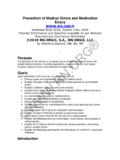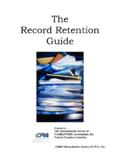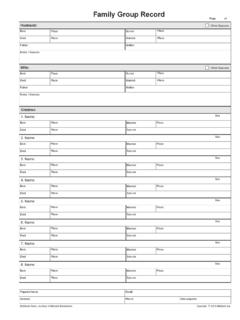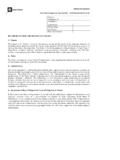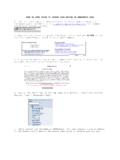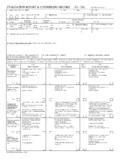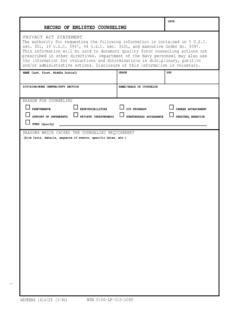Transcription of Medical Record Documentation and Legal Aspects …
1 Medical Record Documentation and Legal Aspects Reviewed May, 2017, Expires May, 2019 Provider Information and Specifics available on our Website Unauthorized Distribution Prohibited 2017 , , , LLC By Wanda Lockwood, RN, BA, MA Purpose The purpose of this course is to outline accuracy and Legal requirements for nursing Documentation , including a review of different formats for Documentation . Goals Explain the purposes for Documentation . Explain the differences among the NANDA nursing diagnoses, Nursing Interventions Classification (NIC), and Nursing Outcomes Classification (NOC). Discuss the Health Insurance Portability and Accountability Act, Privacy Rule. List and explain at least 8 different factors to consider in Documentation . Explain how to document errors, continuations, and late entries.
2 List and explain the primary characteristics of different formats for Documentation . Explain how critical pathways are used. Discuss 3 common components of computerized Documentation systems. Introduction Documentation is a form of communication that provides information about the healthcare client and confirms that care was provided. Accurate, objective, and complete Documentation of client care is required by both accreditation and reimbursement agencies, including federal and state governments. Purposes of Documentation include: Carrying out professional responsibility. Establishing accountability. Communicating among health professionals. Educating staff. Providing information for research. Satisfying Legal and practice standards. Ensuring reimbursement.
3 While Documentation focuses on progress notes, there are many other Aspects to charting. Doctor s orders must be noted, medication administration must be documented on medication sheets, and vital signs must be graphed. Flow sheets must be checked off, filled out, or initialed. Admission assessments may involve primarily checklists or may require extensive Documentation . There is very little consistency from one healthcare institution to another. This poses a real challenge for nurses, especially since it is increasingly common for nurses to work part-time in more than one healthcare facility as hospitals use temporary nursing agencies to fill positions. Understanding the basic formats for Documentation and effective Documentation techniques is critical.
4 With the movement toward quality healthcare and process improvement, nurses may be involved in evaluating Documentation and making decisions about the type of Documentation that will be utilized. Accurate Documentation requires an understanding of nursing diagnoses and the nursing process. Nursing diagnoses, interventions, and outcomes NANDA International (formerly the North American Nursing Diagnosis Association) sets the standards for nursing diagnoses with a taxonomy that includes domains, classes, and diagnoses, based on functional health patterns. Nursing diagnoses are organized into different categories with over 400 possible nursing diagnoses: Moving (functional pattern): Impaired physical mobility Impaired wheelchair mobility Toileting self-care deficit.
5 Ineffective breast feeding Choosing (functional pattern): Ineffective coping Non-compliance Health-seeking behavior. These NANDA nursing diagnoses are then coupled with the Nursing Interventions Classification (NIC), which is essentially a standardized list of hundreds of different possible interventions and activities needed to carry out the interventions. The client outcomes related to the NIC are outlined in the Nursing Outcomes Classification (NOC), which contains about 200 outcomes, each with labels, definitions, and sets of indicators and measures to determine if the outcomes are achieved. These criteria, for example, can be used to help determine a plan of care for a client with pain and diarrhea. NANDA Nursing diagnosis NIC Intervention NOC Expected outcomes Chronic pain Pain management Medication management Relaxation therapy Guided imagery Improved pain level Improved comfort Enhanced pain control Diarrhea Management and alleviation of diarrhea Improvement in symptom control Improvement in comfort.
6 Risk for deficient fluid volume Fluid and electrolyte monitoring Fluid and electrolyte balance Each NIC intervention would have a number of possible activities that could be utilized, depending on physician s orders and nursing interventions, to achieve positive outcomes. While not every healthcare institution uses the same databases or lists of diagnoses, interventions, and outcomes, the basic structure is usually similar, and these lists are used extensively to provide a basis for Documentation . Computerized Documentation systems usually incorporate this or a similar taxonomy, so that the nursing diagnoses are entered into the system, which then generates lists of interventions and expected outcomes. In non-electronic Documentation systems, books or kardexes with these listings may be available for reference.
7 Health Insurance Portability and Accountability Act (HIPAA) The Health Insurance Portability and Accountability Act (HIPAA) of 1996 outlines the rights of the individual in relation to privacy regarding health information. The final Privacy Rule was issued in 2000 and modified in 2002. HIPAA provides the individual with the right to decide who has access to private health information and requires healthcare providers to provide confidentiality. Personal information about the client is considered protected health information (PHI), which comprises any identifying or personal information about the client and health history, condition, or treatments in any form, including electronic, verbal, or written so this includes Documentation . If left at the bedside, Documentation must be secured in such a way that it cannot be seen by those unauthorized.
8 Personal information may be shared with parents, spouse, Legal guardians, or those involved in care of the client without a specific release, but the individual should always be consulted if personal information is to be discussed in a room with others present to ensure there is no objection. Some types of care are provided extra confidentiality: These include treatment for HIV, substance abuse, rape, pregnancy, and psychiatric disorders. In these cases, no confirmation that the person is a client may be given. In other cases, an individual may elect opt out of the directory, that is to have no information released to anyone, and this must be respected by all staff. Charting guidelines A common understanding regarding Documentation is that if it s not written, it didn t happen.
9 This is not actually true: even if a nurse forgets to chart a medication, the medication was still given. However, if there is a Legal action and the chart is examined, there is no evidence that the medication was given as ordered, and a nurse that admits to carelessness in documenting has little credibility. Further, if a medication that is not ordered is given in error, failing to chart it doesn t mean it didn t happen. It means that the nurse has compounded a Medical error with false Documentation by omission, for which there may be serious Legal consequences. Regardless of format, charting should always include any change in client s condition, any treatments, medications, or other interventions, client responses, and any complaints of family or client.
10 The primary issue in malpractice cases is inaccurate or incomplete Documentation . It s better to over-document than under, but effective Documentation does neither. State nursing practice acts may vary somewhat, but all establish guidelines for Documentation and accountability. Additionally accreditation agencies, such as the Joint Commission, require individualized plans of care for clients and have standards for Documentation . Nursing process There are many different approaches to charting, but nurses should remember to always follow the nursing process because that s the basis for Documentation , regardless of the format in which Documentation is done: Assessment: Review of history, physical assessment, and interview. Diagnosis: Nursing diagnosis based on NANDA categories.









